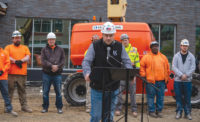To get to the local post office in my town, you can take the sidewalk or cut across a lawn using a well-worn path. This year, the town added flagstones to that shortcut to save the lawn. Quicker and faster always trumps planning.
Humans are an odd lot. We make decisions based on how we are raised and what hurt us or saved us from pain. We always choose what is easy, what we were taught or what we think is right. And that tendency has a lot to do with safety. When humans finally recognize, and admit, how often we make poor decisions, we will prevent construction accidents and kill fewer souls.
Those decisions involve everything from our day-to-day lives to the operation of the most safety-critical equipment. For example, on my roof is an anchorage to tie-off a safety harness when shoveling snow off the skylights. That prevents me from falling through the skylight, but first I must decide to wear my gear and then decide to take the time to connect to the anchorage for a three-minute task. Another, much more complicated type of decision was made by the staff at the Three Mile Island nuclear plant, near Middletown, Pa., in 1979. An emergency core cooling system activated and injected cool water under high pressure into the reactor. Believing the relief valve was closed and fearing they would inject too much water, the reactor crew shut off the cooling water pump. They didn’t understand what was happening, and what they did was consistent with their training. But the result was a partial core meltdown and one of the worst-ever nuclear accidents.
In order to eliminate the remaining fatal accidents in construction, we must remove the chance for someone to make a poor decision or remember to make that decision.
Sometimes we fail to eliminate the conditions that lead to bad decisions. For example, few are aware of the lead exposure from powder-actuated nail guns and similar tools, which rely on small controlled exposions. The shells may contain lead styphnate in the powder charge and rather than banish these unsafe cartridges from use, general contractors often require a subcontractor to implement a lead-exposure monitoring program or suggest using lead-free shells. If we prohibited them from U.S. worksites, the market would dry up, only lead-free shots could be sold and the decision about whether to use them would be eliminated.
There are other examples.
When a worker fell through the skylight of a building in California, the authorities investigated and recommended restricting access to the roof to properly trained employees. But there is a simpler way: require skylights that sustain the weight of a human being. Because we don’t do that now, a killing condition likely remains in existence, waiting for the next warehouse worker.
In order to eliminate the remaining fatal accidents that occur in construction, we must remove the chance for someone to make a poor decision or remember to make that decision.
 |
| Thomas "T.J." Lyons |
There are many areas in which this approach can be applied. We should re-engineer scaffolding so that it cannot be constructed without side railings, then workers would not need to remember to install side railings and the workers would be unable to remove them during the work (that's the way it is done in Japan). We should redesign or prohibit the use of hand-held gas-powered chop or demolition saws, which would eliminate the danger of an operator losing control. Aa we know, when a chainsaw blade jams. the chain halts but the demo saw's blades continue spinning until the worker stops them by touching the saw to the ground — or to a carotid artery.
And we should eliminate the blind spot on some models of rough-terrain fork trucks, as the operator cannot see to the right. This blind spot has figured in fatal accidents, including one that took the life of a good friend of mine, named John Hanson. We should only use rough-terrain fork truck models that allow operators to see to both the left and the right.
Reaching a Safer Future
As we move further into this century, it is time to rid ourselves of unsafe choices embedded in our traditions. We need to supply tools that capture silica, rather than hoping a worker will wear a respirator. We need machines that place pipe in deep excavations so that this dangerous task doesn’t have to be done by our co-workers, neighbors, parents and children. We need electrical panel boxes with warning lights that let craft workers know a killing condition is on the other side and engineered so workers cannot open these when the power is on. My washing machine already has that safety feature.
We must eliminate unsafe choices over what we know is safe and prohibit what we know kills so that it is easier for workers to stay alive and unharmed.
Thomas "T.J." Lyons is a safety director in New York with Gilbane Building Co. He can be reached at tlyons@gilbaneco.com.






